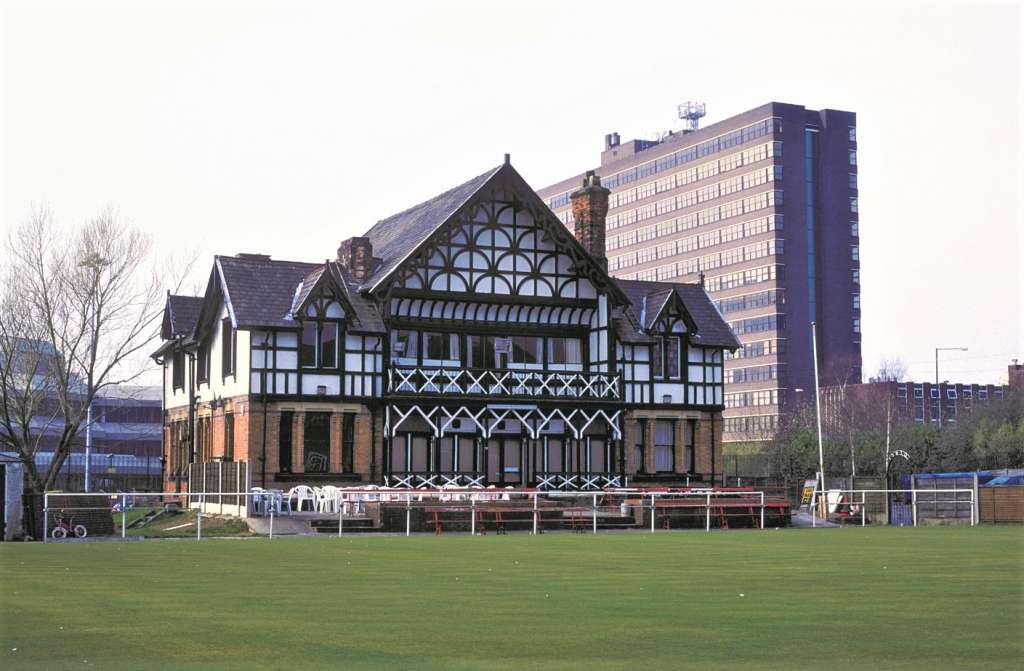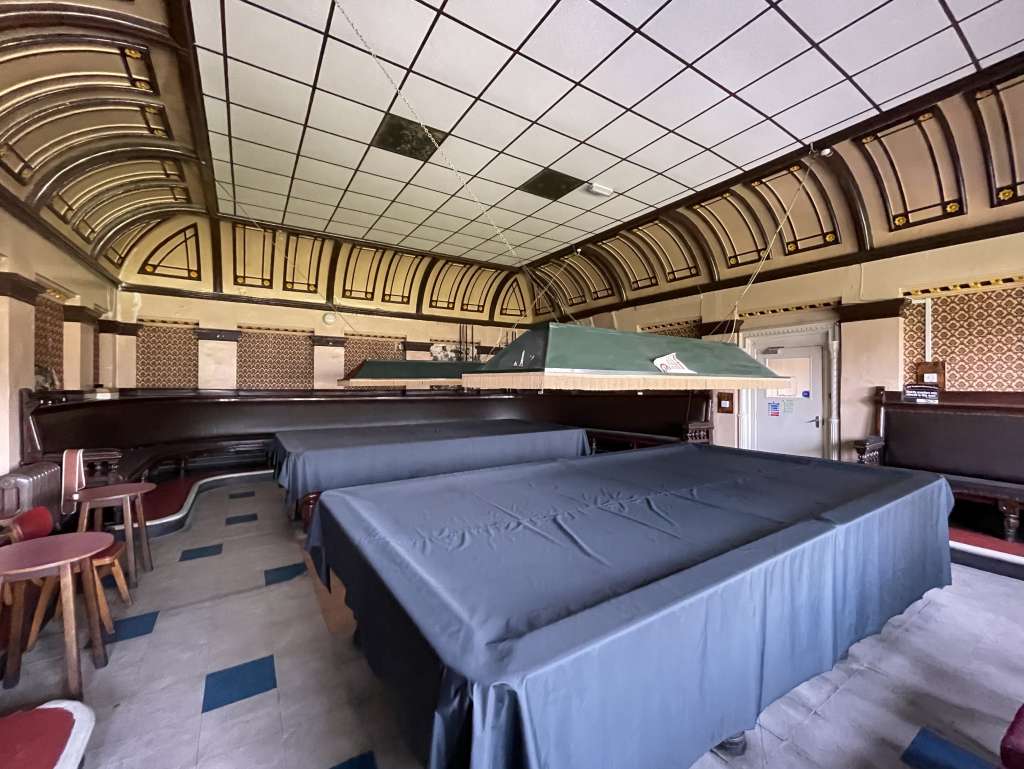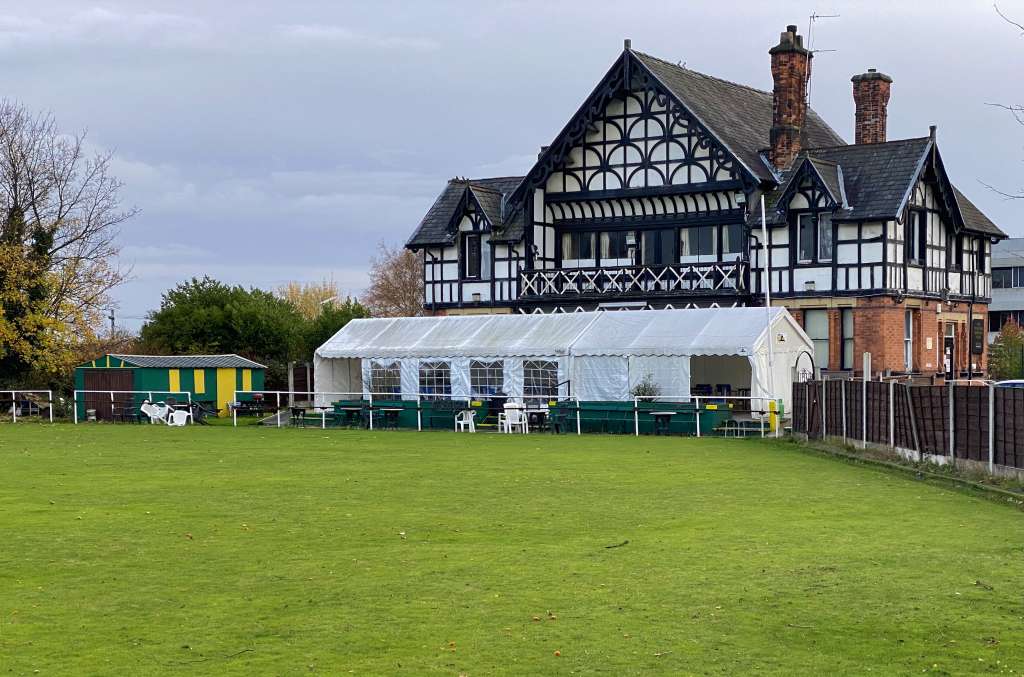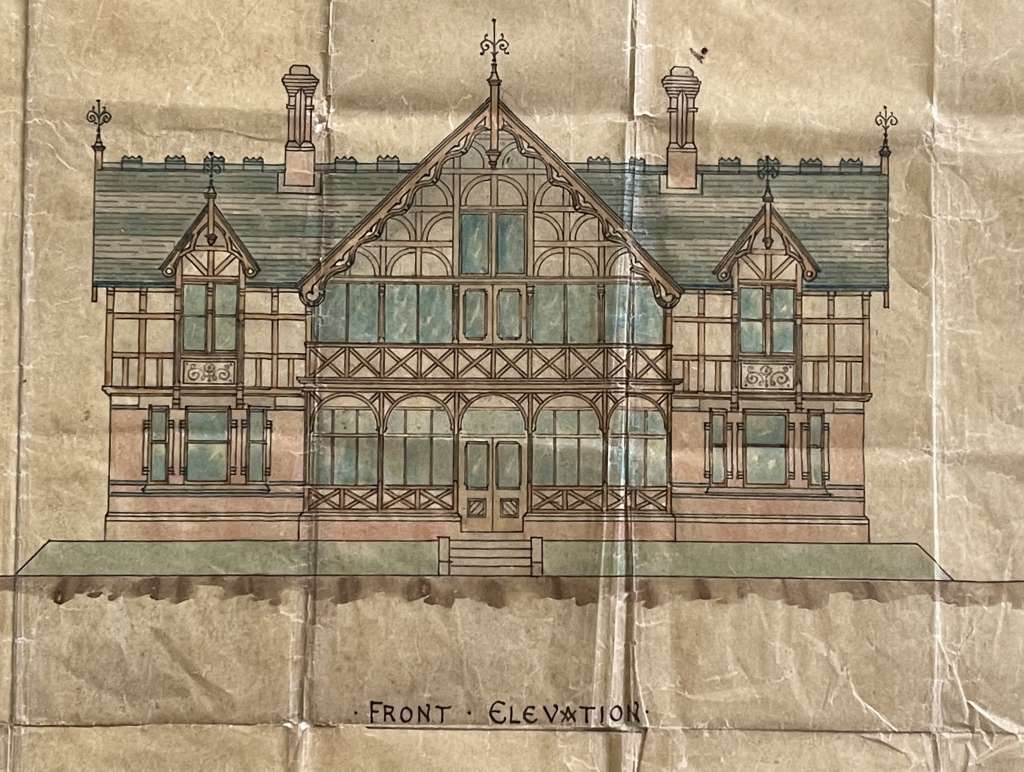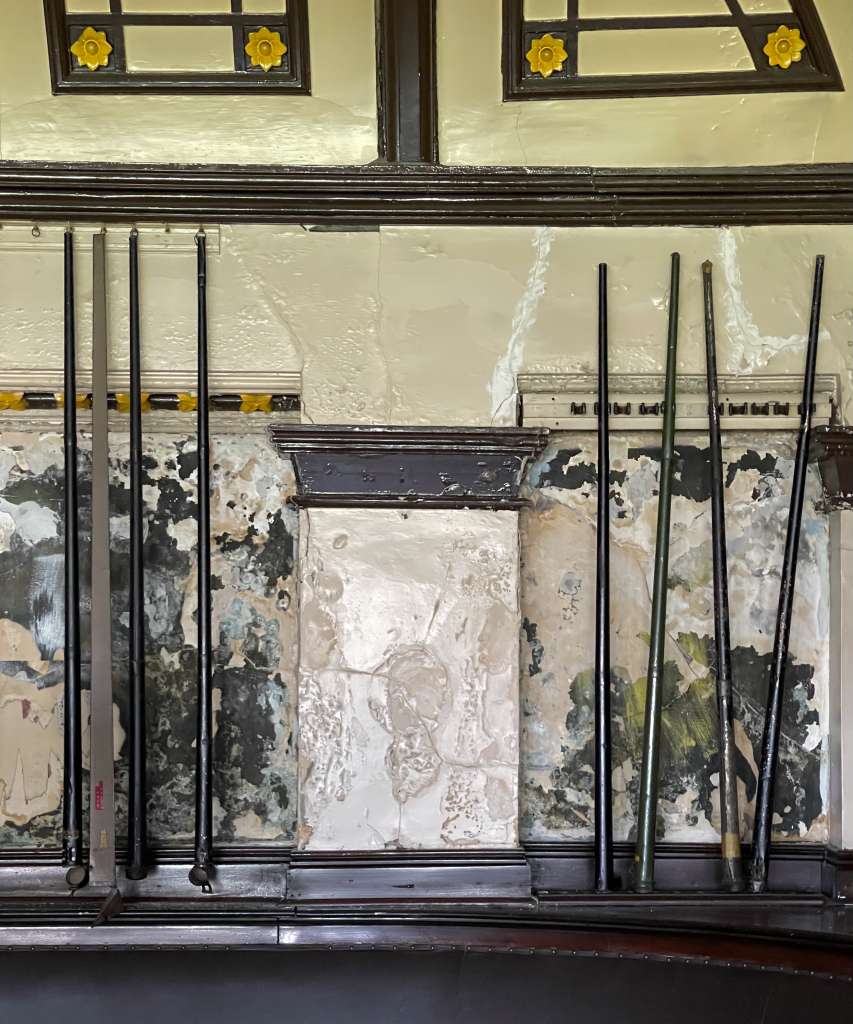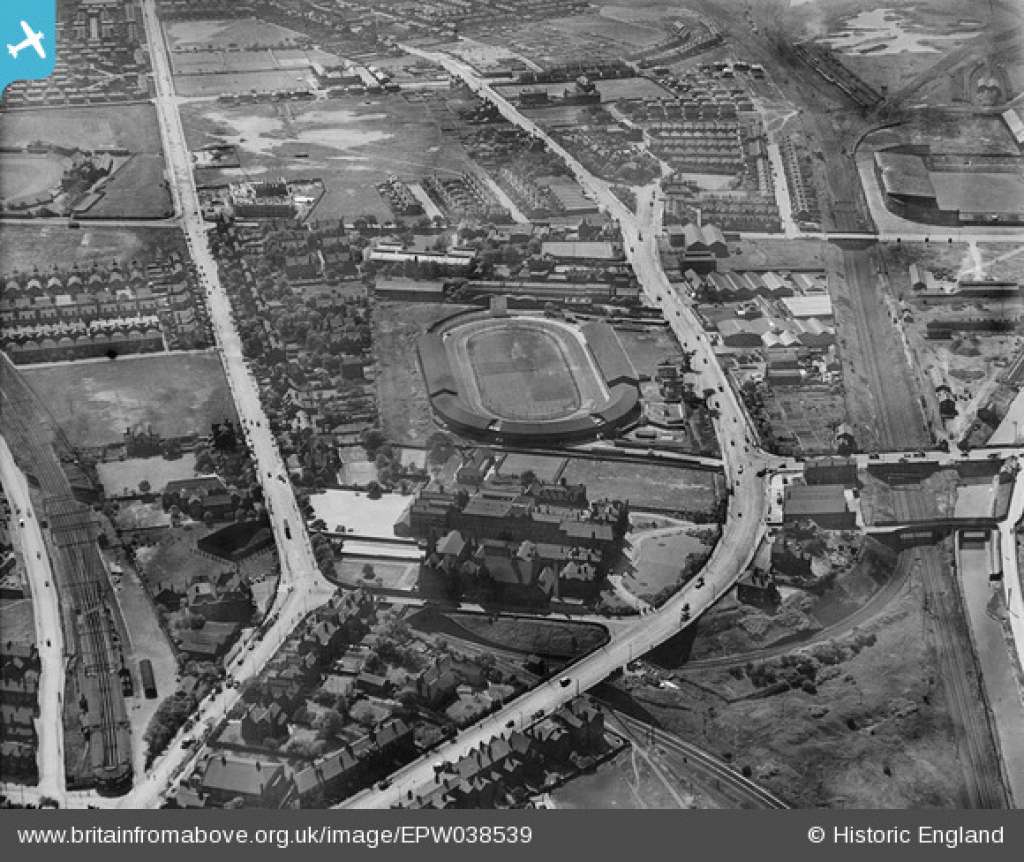PRESS RELEASE: SAVE gets listing bid rolling for Lancashire Bowls Club
4th June 2021
SAVE Britain’s Heritage has launched a listing application to secure the future of one of Britain’s earliest Bowling Clubs in Old Trafford, Lancashire.
Located just a stone’s throw from Old Trafford’s internationally renowned cricket and football grounds, Old Trafford Bowling Club has been largely forgotten in recent decades, despite having been the largest amateur sporting pavilion in the country when built.
Completed in 1877, the grand and unusually ornate black and white timbered clubhouse remains remarkably unaltered today, with numerous original historic and architectural features still intact despite being in continuous active use for nearly 150 years. Of particular interest is the splendid billiards room at first-floor level, complete with its original billiards tables, padded wall seating, ornate plasterwork, elaborate scoreboard, and highly unusual 19th century billiards cues, which still hang on the wall.
Historic clearance of buildings in the surrounding area along Talbot Road has left the clubhouse and green standing rather isolated and now at risk from possible redevelopment, with the entire Trafford area set for largescale regeneration.
Henrietta Billings, director of SAVE Britain's Heritage, says: "The Old Trafford Bowling Club is a remarkable survivor. In continuous use since it opened in 1877, it is complete with bowling green, billiards room and even 19th century billiards cues. It’s a clear candidate for celebration, protection and national recognition with listed building status."
Marcus Binney, executive president of SAVE Britain's Heritage, says: "This is a gloriously unexpected gem of English architecture, an almost miraculously intact survival that continues to flourish. It is a national treasure which deserves to be a listed building."
Ben Oakley, conservation officer at SAVE Britain’s Heritage, says: “Our listing application seeks to recognise Old Trafford Bowling Club as one of the country’s oldest, most ornate and best-preserved sporting pavilions and a key component of the nation’s architectural and historic sporting heritage. Historic England must now recognise the club’s survival and integral contribution to Britain’s enduring international sporting legacy.”
SAVE’s listing application has the blessing of the current club owners and has also gained support from historian and leading authority on sporting heritage Simon Inglis, author and editor of Historic England’s 2004 ‘Played in Britain’ series of books, including Played in Manchester: the architectural heritage of a city at play.
In his letter of support for the listing, Simon Inglis states that: “In terms of its architectural detail, the Old Trafford Bowling Club clubhouse is unusually ornate. Moreover, Bowden’s Tudorbethan styling, while in itself not unusual for vernacular buildings in the north west at this time, lends a presence and a sense of permanence that few new bowling clubs of the period, or of any period could have aspired to or afforded.”
“This relative grandeur, allied to the fact that so few alterations have taken place since 1877 - itself also extremely unusual in this sector - is perhaps the building’s greatest strength. It is therefore the belief of myself and other Played in Britain contributors that the clubhouse of the Old Trafford Bowling Club is a strong candidate for listing.”
History
Established in 1873 by a group of local butchers and merchants, Old Trafford Bowling Club and crown green were formally laid out in 1877 to designs by noted Manchester architect and Surveyor John Bowden, whose eclectic works include, amongst others, the nearby former Trafford Technical Institute on Stretford Road (now a Buddhist monastery) and another Bowling Club pavilion and crown green at Alderley Edge.
The pavilion is of two stories built from polychromatic brick with stone dressings to the ground floor and half timbering with elaborate barge boards above. A slate roof is accompanied by decorative chimney stacks. The clubhouse looks out directly over the green, with an ornate timber and stone dressed balcony at the first floor and a veranda/terrace at ground level.
The size and design of the clubhouse deliberately transcended the mere functional needs of an amateur Bowling Club but was rather intended to project the prestige and wealth of the club, which remains active today 144 years on.
The Clubhouse and green were carefully laid out to meet the practical and aesthetic needs of an ambitious Bowling Club. The orientation of the crown bowling green was important in order to receive the sun in the afternoon, and the Clubhouse was specifically designed to provide facilities for players and spectators recreational usage in connection with the green. It therefore represents an early manifestation of purpose-built spectator facilities for sporting events, of which few are listed today.
Remarkable survival
Despite constant use for over 144 years, the clubhouse survives relatively unaltered internally and retains numerous original features and items by local craftsman.
The ground floor of the main pavilion retains the central members room and bar, opening out on to the terrace where it is understood that the original butchers used to have hog roasts looking out on to the green. Either side of the members room are the original Ladies Room and Card’s Rooms. An unusual 1902 clock gifted to the club by former Chairman of the Manchester Ship Canal Sir William Bailey hangs in the main pavilion commemorating the coronation of King Edward VII and his wife Alexandra as king and queen of the United Kingdom and the British Dominions on 9 August 1902.
At first floor level is housed the club’s original billiards room, complete with two billiards tables, the original (now re-upholstered) built-in benches around the perimeter by Manchester furniture maker M.Beahan and most remarkably, a selection of original 19th century billiards cues which still stand on the wall.
The billiards room opens out with French doors onto a balcony overlooking the bowling green. A false ceiling has been inserted above the Billiards Rooms, which was originally lit by a highly unusual painted glazed ceiling, a panel of which is displayed on the ground floor.
A decision is expected in the coming months and you can access our full listing application report HERE. A full selection of photographs by Mark Watson and Simon Inglis is also accessible HERE.
ENDS
Notes for Editors:
1. For more information contact Ben Oakley, conservation officer at SAVE Britain's Heritage – ben.oakley@savebritainsheritage.org / 07388 181 181.
2. SAVE Britain's Heritageis a strong, independent voice in conservation that has been fighting for threatened historic buildings and sustainable reuses since 1975. We stand apart from other organisations by bringing together architects, engineers, planners and investors to offer viable alternative proposals. Where necessary, and with expert advice, we take legal action to prevent major and needless losses.

